Image caption: Sen. Bill Nelson of Florida welcomes the newly arrived Orion crew capsule at a Kennedy Space Center unveiling ceremony on July 2, 2012 and proclaims Mars is NASA’s long term goal for human exploration. Credit: Ken Kremer
NASA’s first space-bound Orion crew capsule was officially unveiled at a welcoming ceremony at the Kennedy Space Center on Monday (July 2) to initiate a process that the agency hopes will finally put Americans back on a path to exciting destinations of exploration beyond low Earth orbit for the first time in 40 years since Apollo and spawn a new era in deep space exploration by humans – starting with an initial uncrewed test flight in 2014.
Over 450 invited guests and dignitaries attended the Orion arrival ceremony at Kennedy’s Operations and Checkout Building (O & C) to mark this watershed moment meant to reignite human exploration of the cosmos.
“This starts a new, exciting chapter in this nation’s great space exploration story,” said Lori Garver, NASA deputy administrator. “Today we are lifting our spirits to new heights.”
Image caption: Posing in front of NASA’s 1st Orion crew module set for 2014 liftoff are; KSC Director Bob Cabana, Mark Geyer, NASA Orion Program manager, Sen. Bill Nelson (FL), Lori Garver, NASA Deputy Administrator. Credit: Ken Kremer
This Orion capsule is due to lift off on a critical unmanned test flight in 2014 atop a powerful Delta 4 Heavy booster – like the Delta rocket just launched on June 29.
The bare bones, olive green colored aluminum alloy pressure shell arrived at KSC last week from NASA’s Michoud Assembly Facility where the vessel was assembled and the final welds to shape it into a capsule were just completed. Every space shuttle External Tank was built at Michoud in New Orleans.
U.S. Senator Bill Nelson of Florida has spearheaded the effort in Congress to give NASA the goal and the funding to build the Orion Multipurpose Crew Vehicle (MPCV) and the means to launch it atop the most powerful rocket ever built – a Saturn V class booster dubbed the SLS or Space Launch System – to destinations in deep space that have never been explored before.
“Isn’t this beautiful?” said Nelson as he stood in front of the incomplete vessel, motioned to the crowd and aimed his sights high. “I know there are a lot of people here who can’t wait to get their hands and their fingers on this hardware.
“And ladies and gentlemen, we’re going to Mars!” proclaimed Nelson.
“Without question, the long-term goal of our space program, human space program right now is the goal of going to Mars in the decade of the 2030s.”
“We still need to refine how we’re going to go there, we’ve got to develop a lot of technologies, we’ve got to figure out how and where we’re going to stop along the way. The president’s goal is an asteroid in 2025. But we know the Orion capsule is a critical part of the system that is going to take us there.”
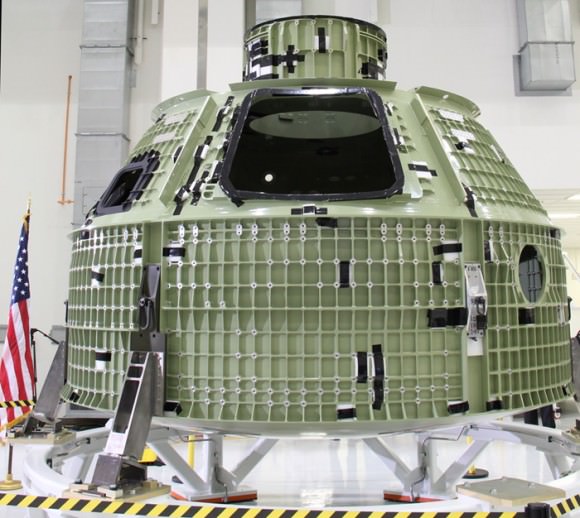
Image caption: The green colored aluminum alloy pressure vessel arrived at KSC last week and will be outfitted with all the instrumentation required for spaceflight. Launch is slated for 2014 atop Delta 4 Heavy booster from pad 37 on Cape Canaveral. Crew hatch and tunnel visible at center. Credit: Ken Kremer
Orion is the most advanced spacecraft ever designed.
Over about the next 18 months, engineers and technicians at KSC will install all the systems and gear – such as avionics, instrumentation, flight computers and the heat shield – required to transform this empty shell into a functioning spacecraft.
The 2014 uncrewed flight, called Exploration Flight Test-1 or EFT-1, will be loaded with a wide variety of instruments to evaluate how the spacecraft behaves during launch, in space and then through the searing heat of reentry.
The 2 orbit flight will lift the Orion spacecraft and its attached second stage to an orbital altitude of 3,600 miles, about 15 times higher than the International Space Station. Although the mission will only last a few hours it will be able high enough to send the vehicle plunging back into the atmosphere at over 20.000 MPH to test the craft and its heat shield at deep-space re-entry speeds approaching those of the Apollo moon landing missions.
Image caption: Sen. Bill Nelson of Florida discusses the new arrived Orion capsule with NASA Deputy Administrator Lori Garver while surrounded by a horde of reporters at the Kennedy Space Center unveiling ceremony on July 2, 2012. Credit: Ken Kremer
Orion arrived at Kennedy on nearly the same day that the center opened its door 50 years ago.
“As KSC celebrates its 50th anniversary this month, I can’t think of a more appropriate way to celebrate than by having the very first Orion Multi-Purpose Crew Vehicle here at KSC,” said KSC Center Director Robert Cabana, a former shuttle commander, at the O & C ceremony.
“The future is here, now, and the vehicle we see here today is not a Powerpoint chart. It’s a real spacecraft, moving toward a test flight in 2014.”
In 2017, an Orion capsule will lift off on the first SLS flight. The first crewed Orion will launch around 2021 and orbit the moon, Lori Garver told me in an interview at KSC.
But the entire schedule and construction of the hardware is fully dependent on funding from the federal government.
In these lean times, there is no guarantee of future funding and NASA’s budget has already been significantly chopped – forcing numerous delays and outright mission cancellations on many NASA projects; including the outright termination of NASA next Mars rover and multi-year delays to the commercial crew program and prior plans to launch a crewed Orion to orbit as early as 2013.
Image caption: Veteran NASA Astronaut Rex Walheim discusses Orion with Universe Today. Walheim flew on the last space shuttle mission (STS-135). Credit: Ken Kremer
Astronaut Rex Walheim, who flew on the final space shuttle mission (STS-135) and has had key role in developing Orion, said the Orion capsule can be the principal spacecraft for the next 30 years of human exploration of the solar system.
“It’s the first in a line of vehicles that can take us where we’ve never gone before,” Walheim said. “It’ll be a building block approach, we’ll have to have a lander and a habitation module, but we can get there.”
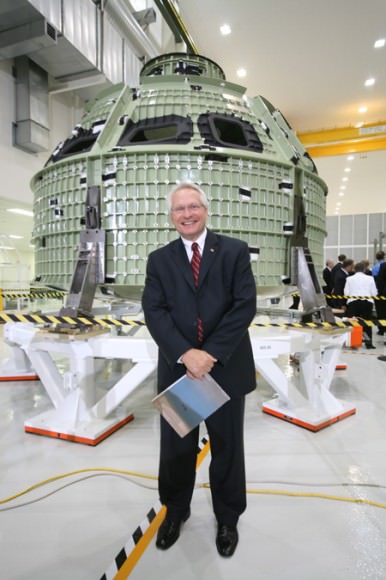
Image caption: John Karas, Lockheed Martin Vice President for Human Space Flight poses with Orion and discusses the upcoming 2014 EFT-1 test flight with Universe Today. Lockheed is the prime contractor for Orion. Credit: Ken Kremer
“Personally I am thrilled to be working on the next vehicle that will take us beyond low Earth orbit, said John Karas, Lockheed Martin Vice President for Human Space Flight. Lockheed Martin is the prime contractor to build Orion.
“Orion will carry humans to destinations never explored before and change human’s perspectives”
“Folks here are ready to start working on the EFT-1 mission. In about 18 months, EFT-1 will fly on the next Delta 4 Heavy flight.
“I can’t wait to go deeper into the cosmos!” Karas exclaimed.
…..
July 13/14: Free Public Lectures about NASA’s Mars and Planetary Exploration, the Space Shuttle, SpaceX , Orion and more by Ken Kremer at the Adirondack Public Observatory in Tupper Lake, NY.

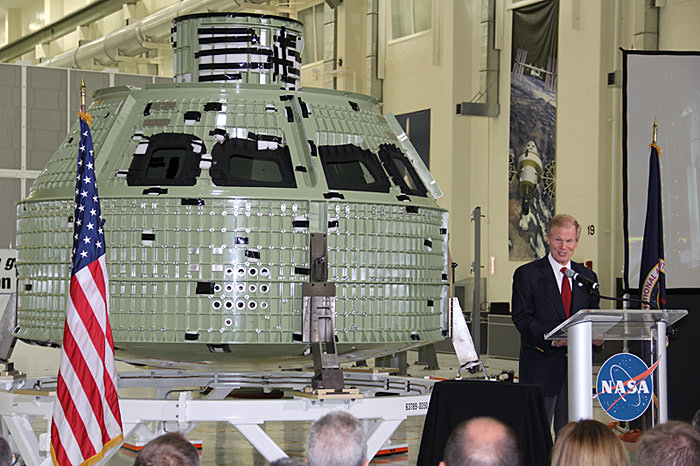
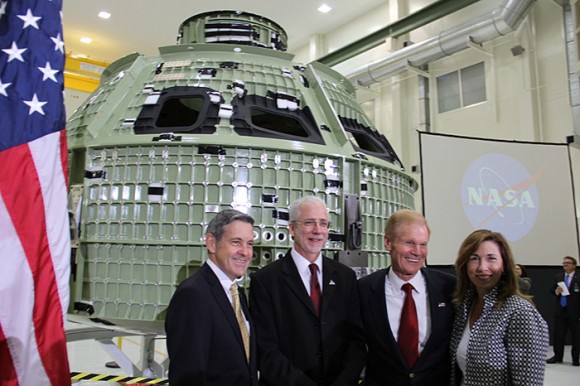
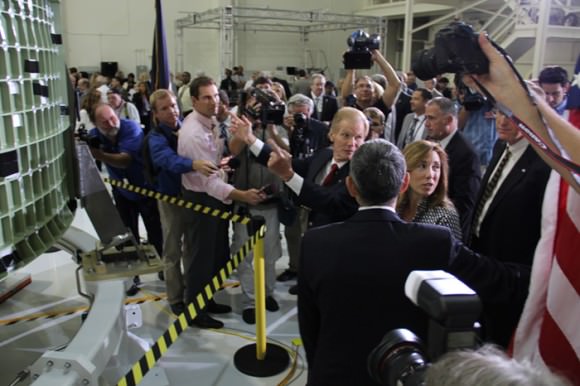
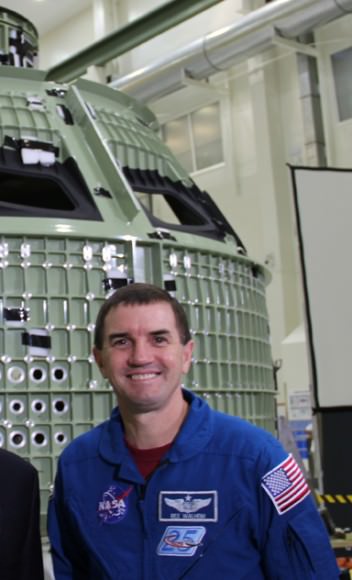
Orion, like a newborn babe, ready to shine. I hope she does.
The article states, without quotes:
Orion is the most advanced spacecraft ever designed.
Just like it states:
Lockheed Martin is the prime contractor to build Orion.
So – are both of these the opinions of UT?
I like UT for the science and astronomy content.
I’m ok with mission coverage, but please put an emphasis on science missions.
If you’re going to report about stuff like this, can you at least please take care to be, well, scientific about it?
Happy 4th!
Well said. I agree the bias here is a thick as honey or cornstarch — showing more and more rheopexy behaviour the more you read.
Moreover. Bring on the 5th of July. 🙂
2021.. 8 years is a long time and at the hands of a lot of budget greedy politicians. We’ll see, though.
“…to mark this watershed moment meant to reignite human exploration of the cosmos.”
I really felt quite sick reading this. This comment is just so biassed. (Hard not to tell it is the 4th July.)
So those humans launched Chinese space program are not really human? Is this what you intend to mean?
America is not the only part of the world, and Americans are not the only one exploring (or wanting too explore) the cosmos. This is really parochialism madly disguised in some patriotic flag-waving rhetoric and just shows how out of touch some Americans are.
Space exploration should speak to the living seven billion hearts and minds of all humanity. Our humanity’s future depends on all of us exploring the solar system and Universe for our futures. It is not some grossly off-putting nasty nationalistic or capitalist rant. The only watershed moment here is some long-distant future launch, where really all the greater strides of several other nations are now leaving Americans in their wake – on the 4th of July or not.
They said “human exploration of the cosmos” not to be confused with American exploration of the cosmos. (although that wouldn’t be intirely inaccurate.)
I’m well aware that the rest of the world gets understandably frusterated with our government & politics.
But lets be serious for just a second, who else is going to spearhead humanity exploring the cosmos?
Russia? They’ve got the LEO thing down pat but hit a brick wall when it comes to anything involving another body in the solar system.
China? Who just managed to duplicate a feat we managed 60 years ago?
Japan? No manned space program + no funding = no chance. (Although with the money they probably could do it)
EU? Like Japan they have the technology & infrastructure but no way is it going to happen in any of our lifetimes. With mess the whole euro zone is in it would be France & Germany shouldering the vast majority of any undertaking of this magnatude.
So that leaves the good ole USA. As much as some are loathe to admit it when humanity does strikeout into the solar system that craft is gunna courtesy of the US.
Nice cherry picking. No matter how you twist or turn, the quote’s implication is perfectly clear.
Americans and the American space program, have, and continue to do remarkable things in the exploration of space, in which they should be proud. No one can deny that. But please, stop carte-blanch speaking for all other 195 nations, or in the egocentric delusion that space exploration can only be achieved under one clearly antagonistic and biassed country’s umbrella!
Grrrrrr… This is freaking annoying, where it seems than too many narrow-minded Americans continue to act and think without any possible inkling of some humility or sensitivity. This has nothing to do with “government & politics” nor Americans spearheading anything. It is time and again the central sickening idea that some Americans want to live under a deliberate false delusion — that they pretend to speak for all nations or all humanity when their real motives is really their own ambitions and supporting their own artificial and delusional notions of their place in the world.
Your own response here just reenforces and screams down our throats that view. Clearly from your lousy attitude, as I said before… I can’t wait for the 5th of July.
“But lets be serious for just a second, who else is going to spearhead humanity exploring the cosmos?…..
….China? Who just managed to duplicate a feat we managed 60 years ago?”
Just because China is in the beginning stages of manned exploration doesn’t mean it will take decades for them to match current U.S. ambitions. That’s a little ridiculous, don’t you think? Given current technology and international collaboration that wasn’t seen 60 years ago, China has an opportunity to contribute great things to space exploration. I mean, come on. Even though many Americans haven’t socially evolved past national pride, the scientific community is tearing down borders that are now useless to furthering the collective pool of knowledge and advancing the human race.
“China? Who just managed to duplicate a feat we managed 60 years ago? ”
This is the silliest argument I keep hearing about China. What do you expect them to do?! Go from scratch to land on Mars? Are you really going to trivialize their successful efforts to launch men and a space station in the past decade?
By the way, America was the 2nd nation to launch a man to space. We can all then say that they just “duplicated” a feat that the Soviets accomplished a few months before. Does that sound fair to you? I sure hope not. Then stop with the China-bashing.
If they don’t do say things like that, NASA’ll NEVER get money to do the things they do. No matter how much we want it to be about humanity as a whole, it’ll never happen (the getting money part) without tossing in some nationalism. Every space program does it. China was pushing their 1960’s space program like nuts too.
China never had a space program in the 1960s. You mean Russia I’d think.
Looking at the first three flights in Orion’s test schedule (2014 and 2017 unmanned and 2021 for the first manned flight), it appears that the idea of using Orion as a lifeboat attached to the ISS has quietly died a natural death.
If so, good. Just the Delta 4 Heavy boosters alone for the ISS lifeboats would have cost $375 million each and there are far better ways for NASA to spend it’s limited funds.
This thing is just FUGLY…. The Apollo guy’s are turning in their graves…
This is only the inside shell you moron!
I think it is just sad to see so much Nelson and so little space.
I’m quite sure that distinction goes to ISS and its ilk. They can and do manoeuver independently to adjust orbits, attitude and to avoid meteors.
The next step down would be the Shuttle and its ilk. They have many flight and reentry modes, from LEO down to ground.
The next craft is probably the manned Dragon with SuperDracos, who currently is a lot more finished than the Orion. It too has more flight and reentry modes from LEO down to ground.
If you mean translunar space crafts: yes, it will be more advanced than the Apollo that was retired for that purpose exactly 40 years ago. Almost diddly-squat more than the then Apollo advanced concepts for extended missions of the same type, I note. We knew how to do Orion then, and luckily we still know how to do it now.
Of course you need something like this. But it is the habitats that will be the new, exciting stuff for the NEO missions – even if they too improve old technology (ISS modules).
Hmmn… I can’t tell if it looks more like an Apollo capsule – which was seriously innovative in the 1960s, or a SpaceX Dragon – which is available commercially off the shelf today. Oh well, at least Orion will be safer than the STS.
Unless the Orion program goes as originally planned, to establish a permanently crewed station on the moon, it’s all a waste. A Mars mission is just a stunt unless long term habitation is the plan and it’s far easier to get that experience on the moon. Without that building block, a Mars mission will be just like Apollo and idiot politicians will kill it as soon as it can no longer get them good p.r.
To be cancelled and the money saved to be given away to the big banks and major lenders. We will be lucky if they even finish the JWST project, MARS was thrown away back in the 70’s. Taken us 40 years to think about visiting it. This snail paced way of advancement doesn’t go well with the general public, hence why there is little interest nowadays in the space program.
Looks a lot liek the 60s capsules, I mean there is only so much you can do lol.
Mega-Privacy.tk